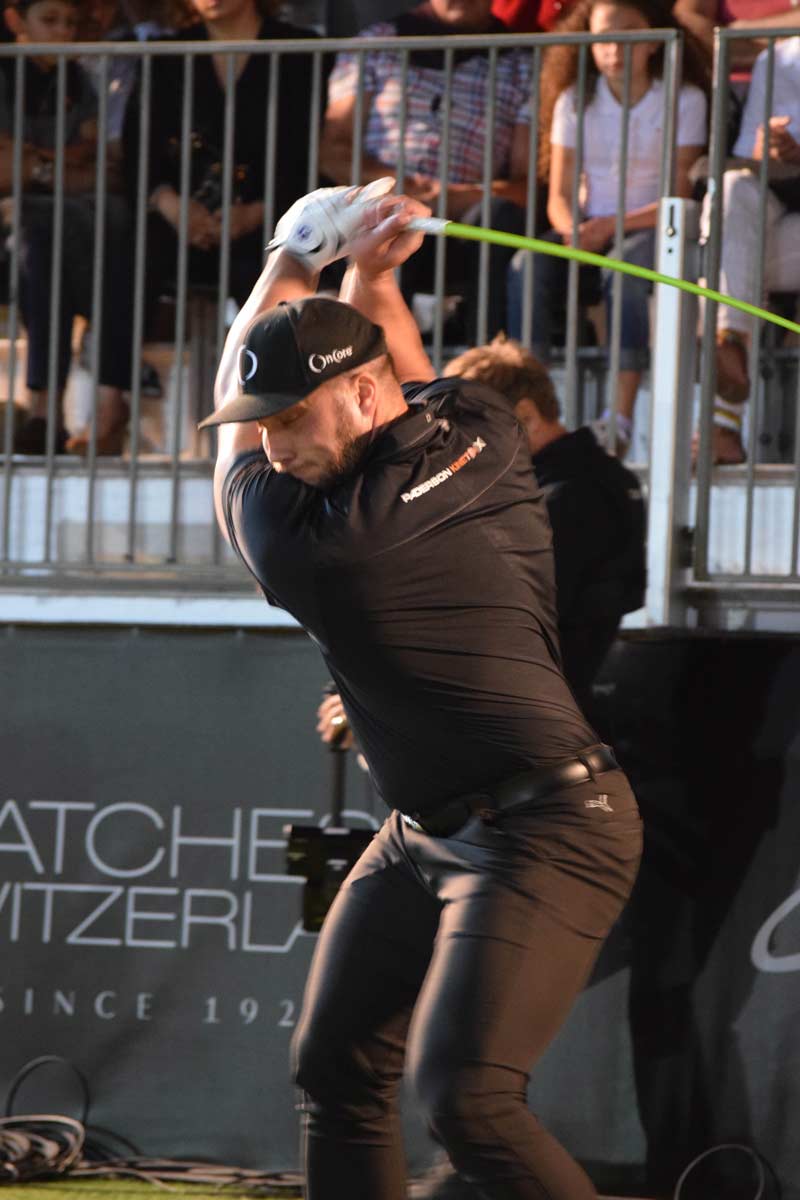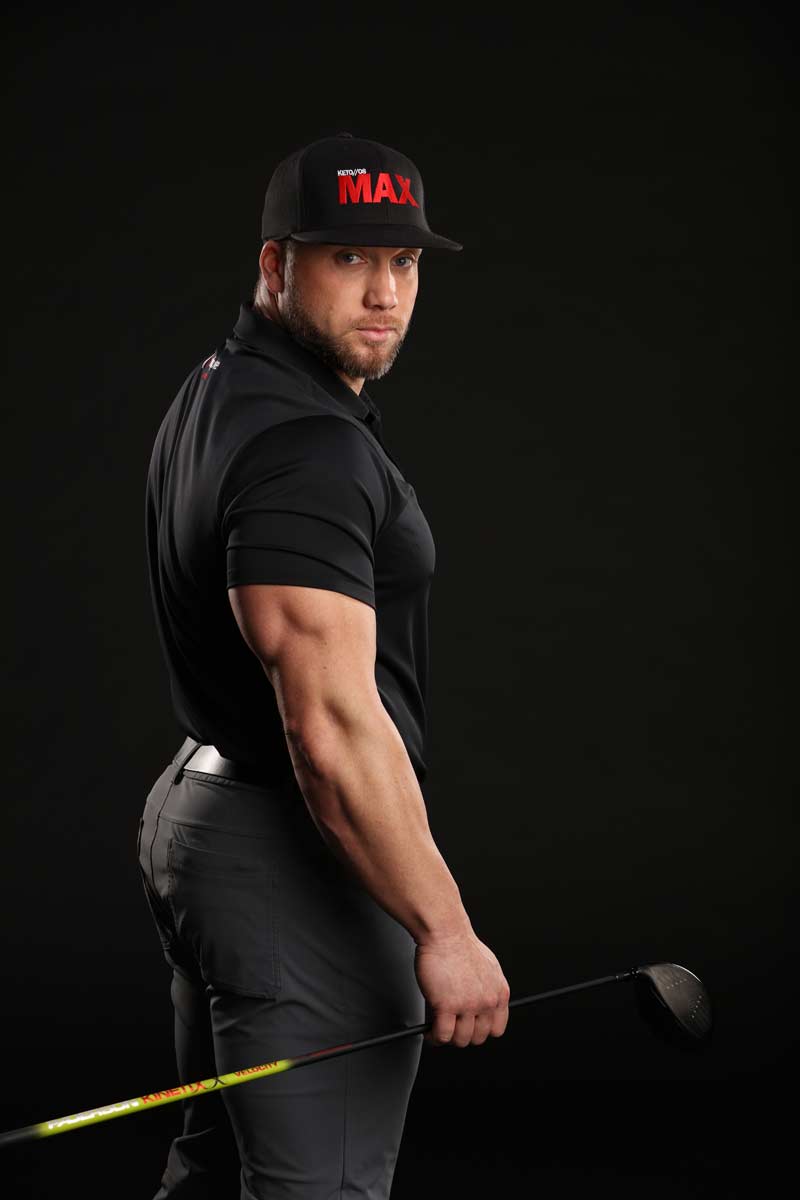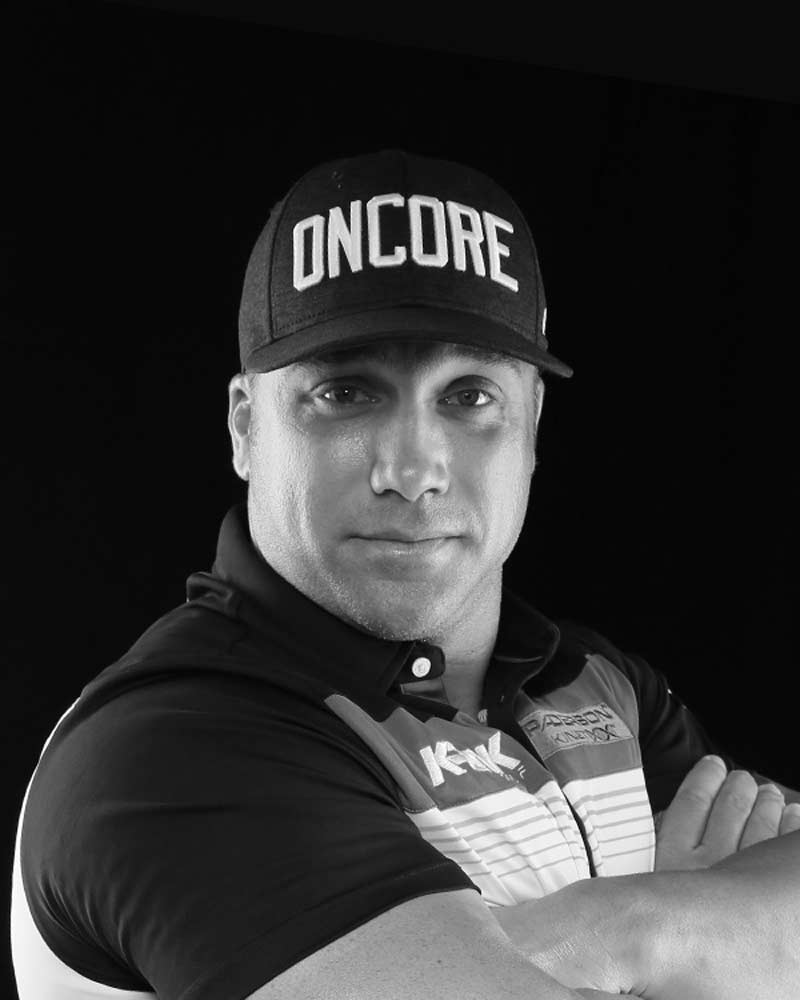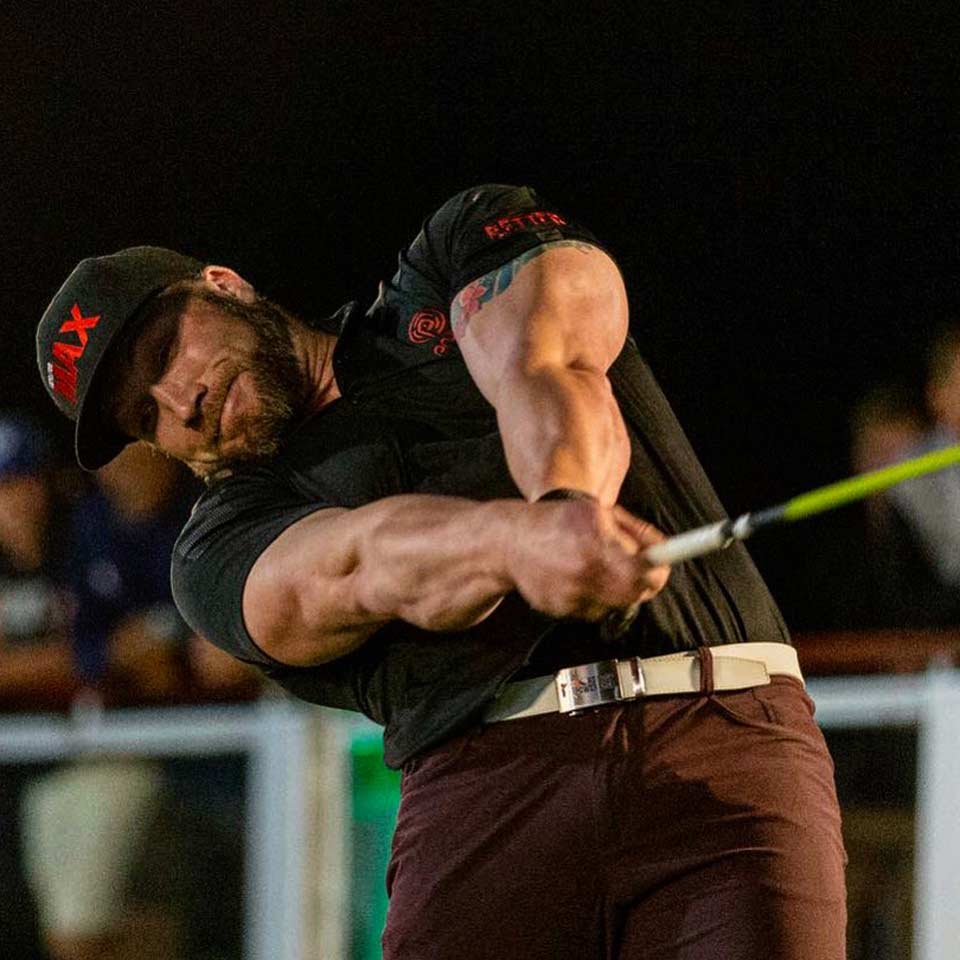Let’s get this out of the way from the get-go—Ryan Steenberg is not normal. It’s not normal to drive a golf ball 300 yards and hit baseballs “off the planet” at age eleven. It’s not normal to play two years of quarterback at the collegiate level and then switch to the opposite side of the ball as a strong side linebacker and “wedge-buster” on special teams. It’s not normal to take that natural, genetic explosiveness and still be so dedicated and driven in the weight room that you’re prepared to turn around and begin formally training youth athletes by age nineteen. And it’s not normal to launch a career as a World Long Drive Tour champion by dropping in at a PGA trade show for business and networking purposes, only to fall in with a crew of professional long drivers and best them all in an exhibition at the event.
“The President of Krank Golf asked me how long I’ve been doing long drive and I said about 20 minutes. He sent me some drivers and the rest is history,” says Steenberg, recalling the spontaneous competition with Landon Gentry, Kevin Shook, and Ryan Winther that sparked his entry in the sport. “I’m kind of the freak-beast of the tour. I’m that body-building, strong-side linebacker freak-o that should not be able to hit a golf ball. I do it with the best in the world and do it with a decent golf swing to boot.”
Yet for all the “freak-ish” elements of Steenberg’s route to his current #4 ranking on the World Long Drive Tour—“bringing the BOOM” for the Ithaca University football team, progressing as a powerlifter post-college, and backing into long drive from the business side as the creator of the Twitch Trainer—his athletic career has been based on fundamental principles of training and development. Multi-sport participation as a youth athlete, including baseball, basketball, football, and track; a set of weights in the basement from the age of thirteen and a stack of magazines demonstrating exercises and proper lifting form. As a teenager his mindset shifted from lifting to build muscle to lifting as a means to improve athletic performance, leading Steenberg to begin working out at Strength In Motion in Syracuse, where he developed the core principles that guide his training and coaching today.
[av_button_big label=’More golf:’ description_pos=’below’ link=’manually,https://1080motion.com/ben-shear-golf-1080-quantum/’ link_target=” icon_select=’no’ icon=’ue800′ font=’entypo-fontello’ custom_font=’#ffffff’ color=’theme-color’ custom_bg=’#444444′ color_hover=’theme-color-subtle’ custom_bg_hover=’#444444′ av_uid=’av-154cfr9′]
1080 Quantum for golf swing training: Ben Shear on the right time for S&C
[/av_button_big]
“I’m a highly trained individual, I’ve been training for over 20 years,” says Steenberg, who packs 250 lbs of muscle onto a 5’10” frame at age 35. “Which means it’s going to be harder for me to go out and get that 1-3% improvement than someone whose training age is maybe 3-5 years. It’s harder for me to stimulate my body in such a way that it promotes adaptation. And that’s where the 1080 comes in for me, personally.”

Load and Explode
While high performance training methods in golf have become a greater and greater part of the sport over the past decade—with Rory Mcllroy, Dustin Johnson, Jordan Spieth, and other top players lifting heavy as part of their regular strength regimen—there remains some pushback to the idea of loading swing patterns and engaging in certain forms of hypertrophy training, out of fear those exercises will disrupt the fluidity of the golfer’s swing.
“Anybody just watch the last year of professional golf unfold?” Steenberg says, when asked about these traditionalist concerns. “Mr. Tiger Woods just won again on Sunday. Post, what, four back surgeries? Right? And a bunch of physical ailments. In my mind, if he didn’t have a foundation of resistance and hypertrophy training, he never would’ve come back to the sport. And he also posted the fastest club head speed reading of anybody this year, I think 128 miles per hour. At 40-years-old.”
Training for explosive power on the course, PGA players have integrated programs with squats and trap bar deadlifts, mixing in med ball throws, kettlebells, and band-work for rotational force. As he targets maximal club head speed and ball speed off the drive—both for his own training and the high level golfers he works with—Steenberg adds resistance and tension to hip-thrusters, rotational chops, punches, and ballistic vertical jumps.
“A couple kids that I work with now—Kramer Hickok in particular, who finished second on the money list on the web.com tour and earned full PGA tour status for 2019—he’s a kid that was a gym rat at the University of Texas,” Steenberg says. “We kind of tweaked his training a little bit, I got him stronger. We focused on building functional strength for golf and we lifted heavy. We deadlifted heavy, we pressed heavy, we rotated heavy, and then we started working into that newfound strength of his and we taught him how to explode. Load and explode, right? He went from 109-110 mph with his swing to 119 mph in a year and a half… and that wasn’t built on a tee-box, that was built in the gym.”
Top End Gains with 1080 Quantum
“I’ve taken what I’ve done in the gym, those traditional movement patterns that you would do with a weight stack or with bands, and I’ve applied those to the 1080,” Steenberg says. “With the various and extremely diverse ways of loading those, you have an infinite amount of ways to challenge those patterns with the 1080. That’s really where, for me, I think the benefit has come. So I can work in sequence, I can work in pattern, I can work in rotation, I can work in lateral drive, and I can load rotation. I can load my golf pattern, I can load my sequence in high tension environments…and obviously claw all the way back to very, very low resistance, almost no resistance, very high speed ballistic movements.”
Given his advanced training age, Steenberg recognizes that eliciting physiological adaptations requires a new range of stimuli and imposed stressors, and that these advanced loading schemes are targeting so-called marginal gains. But the 1-3% of top end power gains that Steenberg is chasing are the competitive difference-makers in terms of pushing club head speed, ball speed, and total distance off the tee for an elite athlete.

“Some of my favorite moves are rotational hip-thrusters and rotational chops,” Steenberg says. “I’ll complex those, and do a very, very high tension movement to pre-set the pattern and wake the body up, and then I’ll taper it into more of a power movement with mid-resistance for max power. And then I will taper that even down further into max speed and I will hit all three systems, max strength, power, and speed in succession.
“For me, that 1-3% performance gain that I was searching for, I knew that if I got that 1-3% gain this year that I was going to win,” Steenberg continues. “Which I did, twice. I knew that I would crack the top five in the world, which I did. And I wanted to see ball speeds on multiple occasions above 220 mph, which I did. I knew that if that 1-3% showed up, that I would reach my goals and I’ve basically hit every goal that I wanted this year other than a World Championship. And the 1080 is absolutely the catalyst to all that, no doubt.”
Championship Goals
Despite the successes and accomplishments of his past two years on the tour, Steenberg is in no way satisfied. Even with his current longest drive sitting at 485 yards, he still thinks he has another 10-15% he can add to his ability to smash a golf ball. Which means he’s still chasing those incremental 1-3% gains, still scrutinizing his training plans and methodology, still chasing Will Hogue, Maurice Allen, and Justin James at the top the World Long Drive rankings.
“In the last two years, I’ve found that I peak towards the end of the year with my club head speeds and ball speeds,” Steenberg says. “That usually shows up like mid-July and lasts through September. There’s obviously a time in my season at the beginning of the year where I have to get out of the box and hit the ball like I do in September. So I’m still trying to personally figure out how to get those speeds earlier in the year. That’s something I’ll address in my training over the (coming) winter. Staying more explosive, staying fast, staying with that speed dimension where it needs to be. For me, personally, there is a point where you can be strong enough, and I’m strong enough. Now it’s about trying to be explosive and grab more speed.”

Steenberg plans for three peak phases in his competition schedule, targeting April, July, and September. As he continues to work toward adding explosiveness and club head speed throughout the entire competition season, in addition to manipulating resistance with 1080’s Isokinetic mode, eccentric speed limits, and No Flying Weight setting, Steenberg also uses 1080’s platform to guide and motivate his progress, using the trend views to track his progress on the force-velocity curve.
“My favorite part about it is it brings real-life data into play,” Steenberg says. “So, I’ll do a pre-round speed workout like seventy-two hours before a competition, and I set the same parameters across the training… if I’m faster four weeks later than the four weeks before, I know I’m firing harder. And I can obviously track all that data, see where some of the gaps might be, tweak it a little bit, go back, and really set some goals for myself based on the previous data. Which obviously is going to contribute to mental drive, which changes my intent… and when you’re hitting a golf ball it’s all about intent.”
[av_button_big label=’Next post:’ description_pos=’below’ link=’manually,https://1080motion.com/applying-1080-quantum-clinical-setting/’ link_target=” icon_select=’no’ icon=’ue800′ font=’entypo-fontello’ custom_font=’#ffffff’ color=’theme-color’ custom_bg=’#444444′ color_hover=’theme-color-subtle’ custom_bg_hover=’#444444′ av_uid=’av-lvib39′]
To Heal and To Correct: Applying the 1080 Quantum in a Clinical Setting
[/av_button_big]
Intent in training—Steenberg credits his explosive work with the 1080 Quantum with improving his vertical jump (a standard benchmark of power and readiness) an inch and half peaking out at 33 inches, not bad for a 250 pounder at the age of 35. And, intent on the tee—Steenberg’s sights are set on nothing less than a World Championship and number one ranking.
“I mean, you’re talking to a long driver, right?” Steenberg says. “So, there’s always more—you can always go faster, you can push the norm. I honestly think 1080 has done it. They’ve broken the box. That old training attitude and methodology of the gym and stacks of plates, bands, and chains… the 1080 has basically made all that obsolete. This is the next wave. So as I reach for the next 1-3%, there is no doubt that 1080 will get me there.”






























































